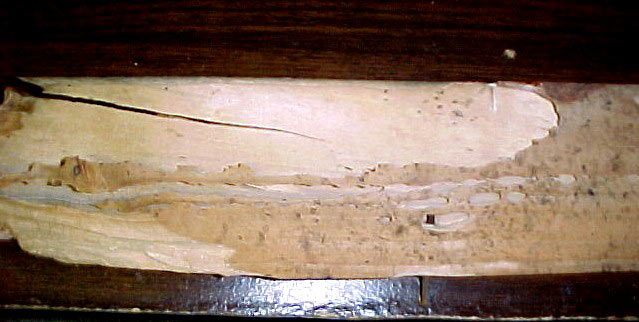
Carpenter Ant Inspection
Learn the signs of carpenter ants in your house and how to get rid of carpenter ants.
One of the most critical steps for carpenter ant inspections is to look out for any signs that they may have been trailing or nesting. These signs include frass, wet wood, and trails left behind by them or even sounds. The best time for inspection would be at night or early morning with a flashlight as you can more easily see carpenter ant trails.
Carpenter Ant Inspection: Look For Carpenter Ant Signs

Frass:These are wood shavings that the carpenter ants kick out of their galleries after they have excavated, dead insects, and waste products from feeding.It looks like sawdust and is found near nest sites. Sawdust debris discarded from the carpenter ants making their galleries
Wet Wood: If woodwork has been damaged by water, it is an ideal location for carpenter ant nests. The carpenter ants do not digest the wood for food (like termites), but make their homes in the weakened wet wood.
Ant Trails: As with many ants, carpenter ants form trails that can be seen among window sills, door frames, baseboards, eaves outside, power lines, telephone poles.
Sounds: Sounds like a rustling in the walls as they move around and build nests
How To Detect Carpenter Ant Galleries

Carpenter Ants clean and polish their nests and push out debris (shavings, frass) through holes.
Use a screwdriver to probe the wood near a suspicious area; this may reveal excavated galleries.
Frequently you can see what looks like sawdust near Carpenter Ant galleries. This sawdust, known as frass, is shredded fragments of wood that have been ejected from the galleries. This is a good indication that a nest is nearby.
If you suspect Carpenter Ants are present but there is no frass, use the handle of a screwdriver to tap along baseboards and other wood surfaces, listening for the hollow sound of damaged wood. If a nest is nearby, often the Carpenter Ants will respond by making a rustling sound within the nest, similar to the sound of crinkling cellophane. Use a screwdriver to probe the wood near a suspicious area; this may reveal excavated galleries.

When To Inspect

Because Carpenter Ants forage primarily at night, use a flashlight and conduct inspections in the evening or early morning to locate foraging trails and nest sites. Remember, workers have been known to travel as far as 100 yards from the colony to search for food and water. You may have a long way to go to find the nest of those Ants you found in your kitchen.
Parent colonies contain the egg-laying queen with its broods, as well as the worker ants. The satellite colony has mature larvae and pupae as well as workers. Inspect wooden structures associated with high moisture, where there may be water damage resulting in softened and moist wood. Carpenter ants will inhabit wood structures that have already been damaged by water or insects.
Carpenter ants prefer frames and sills of windows and doors, as well as tub enclosure walls, kitchen and bath plumbing walls, around sinks, chimneys, and in hollow spaces such as wall voids.
Indoors
- Moisture problem areas
- Wall voids
- Attics (especially under roofing and insulation)
- Flooring or sub-flooring and along carpet edges
- Ceilings
- Windows
- Skylights
- Hollow doors
- Dishwashers
- Trash compactors
- Plumbing, pipe chases (kitchen/bath)
- Pet food locations (both inside and outside) will attract carpenter ants
Outdoors
- Trees and Stumps (may be nesting in dead or moisture damaged trees or stumps)
- Along sidewalks and walkways (sidewalks are used a lot by ants to go to and from their food source and nests).
- Around the foundation (maybe below grass covering)
- Fence lines-Often used by ants to trail
- Deteriorating landscape timbers or railroad ties
- Woodpiles and Firewood
- Leaf litter
- Debris piles
- Mulch beds
- Door kick plates
- Rooflines and gutters
- Soffits and vents
- Windows and door frames
- Utility entrances (electric, cable, TV, telephone, gas lines)
- Sheds and doghouses
- Trash containers
We carry a special kit (DIY Complete Carpenter Ant Kit) with Taurus SC, plus two ant baits: Maxforce Fleet Ant Bait Gel, a sweet-based bait, and Advance 375 A Ant Bait to provide for the Ant's protein-based dietary needs.
DIY Complete Carpenter Ant Kit made up of Taurus SC and Carpenter Ant Baits at a reduced cost.
To locate Carpenter Ant nest sites and trails, focus on these areas:

Field Ants
The Field Ant (Formica) may be identified as a carpenter ant. Both carpenter ants and field ants have one node or a one-segmented waist. The field ants have an uneven thorax, and the carpenter ants have an evenly rounded thorax. The Field Ant may be found throughout the US.
Field ants may come inside to forage, but do not establish nests inside like the carpenter ant. They nest in soil or decayed logs and construct their nest from grass stems, twigs, pine needles, etc., forming a mound. They form low profile mounds in the yard. Their mounds can reach a foot or more in diameter. If the mound is disturbed, they may aggressively swarm out ant bite the intruder. The bite may sting.
Field Ants are commonly noticed during the fall months as they swarm from underground to new locations to establish new colonies. Use an ant bait granular around the mound like Maxforce Complete Ant Bait.













